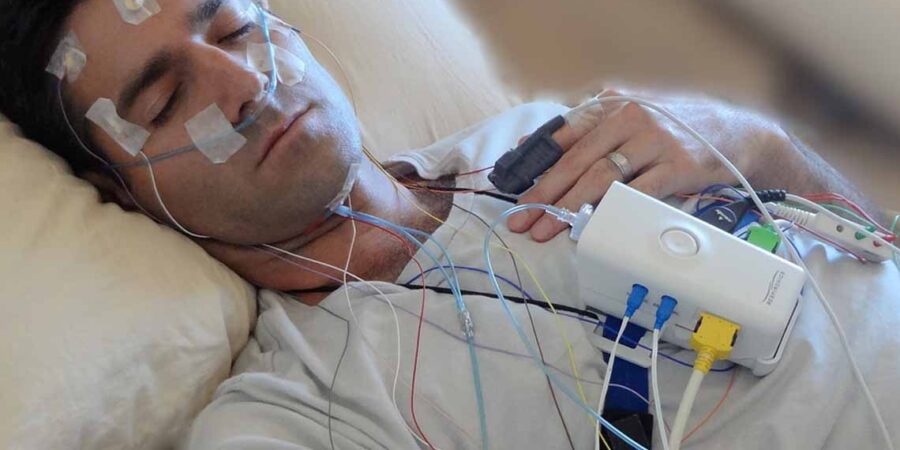Polysomnography
Polysomnography, also called a sleep study, is a comprehensive test used to diagnose sleep disorders. Polysomnography records your brain waves, the oxygen level in your blood, heart rate and breathing, as well as eye and leg movements during the study.
Polysomnography may be done at a sleep disorders unit within a hospital or at a sleep center. While it’s typically performed at night, polysomnography is occasionally done during the day to accommodate shift workers who habitually sleep during the day.
In addition to helping diagnose sleep disorders, polysomnography may be used to help initiate or adjust your treatment plan if you’ve already been diagnosed with a sleep disorder.
Sometimes you may be able to do the sleep study at home. Home sleep apnea testing uses a limited number of sensors to focus primarily on diagnosing obstructive sleep apnea (OSA).
Why it’s done
Polysomnography monitors your sleep stages and cycles to identify if or when your sleep patterns are disrupted and why.
There are different types of home sleep apnea test devices using different combinations of sensors. They generally record your breathing rate and airflow, as well as oxygen levels and heart rate. One style also incorporates information on blood vessel tone.
The normal process of falling asleep begins with a sleep stage called non-rapid eye movement (NREM) sleep. During this stage, your brain waves, as recorded by electroencephalography (EEG), slow down considerably.
Your eyes don’t move back and forth rapidly during NREM, in contrast to later stages of sleep. After an hour or two of NREM sleep, your brain activity picks up again, and rapid eye movement (REM) sleep begins. Most dreaming occurs during REM sleep.
You normally go through multiple sleep cycles a night, cycling between NREM and REM sleep in about 90 minutes. Sleep disorders can disturb this sleep process.
Your doctor may recommend polysomnography if he or she suspects you have:
- Sleep apnea or another sleep-related breathing disorder. In this condition, your breathing repeatedly stops and starts during sleep.
- Periodic limb movement disorder. In this sleep disorder, you involuntarily flex and extend your legs while sleeping. This condition is sometimes associated with restless legs syndrome.
- Narcolepsy. You experience overwhelming daytime drowsiness and sudden attacks of sleep in this condition.
- REM sleep behavior disorder. This sleep disorder involves acting out dreams as you sleep.
- Unusual behaviors during sleep. Your doctor may perform this test if you do unusual activities during sleep, such as walking, moving around a lot or rhythmic movements.
- Unexplained chronic insomnia. If you consistently have trouble falling asleep or staying asleep, your doctor may recommend polysomnography.
Risks
Polysomnography is a noninvasive, painless test. The most common side effect is skin irritation caused by the adhesive used to attach test sensors to your skin.
How you prepare
You may be advised to avoid drinks or food containing alcohol or caffeine during the afternoon and evening before polysomnography. Alcohol and caffeine can change your sleep patterns, and they may make symptoms of some sleep disorders worse.
Napping in the afternoon before a sleep study is discouraged. You may be asked to bathe or shower before your sleep study. But don’t put on lotions, gels, colognes or makeup before the test, as these can interfere with the use of the electrodes.
For a home sleep apnea test, the equipment is delivered to you or you can pick up the equipment at your doctor’s office. You’ll be given instructions describing how to use the equipment. Ask questions if you’re unsure about how the test or equipment works.

FAQs
What are the facilities available at the clinic?
The following facilities are available:
- Pulmonary function testing (Spirometry)
- Bronchoscopy
- EBUS
- Sleep studies (polysomnography)
- Thoracoscopy
- Lung cancer chemotherapy
I snore. Do I need to undergo a sleep study test?
It is not necessary that all persons who snore need to undergo a sleep study. There should be associated features to label it a disease. You should seek consultation from a sleep specialist in this case, who will screen you appropriately.
What will happen to my body if I sleep less?
Sleep is one of the key factors that determine the health of an individual. How one wakes up in the morning is a fair indicator whether one is getting a proper sleep or not. Therefore, if you have been snoozing your alarm too often, you might be damaging your own health. Experts believe that under normal circumstances, one should be able to wake up refreshed. And if you are not then you might be suffering from a sleep disorder. This can cause neurological changes in your body and can reduce the productivity at work. Moreover, in the short run it can cause memory problems and severe hormonal changes in your body.
Whatv is Pulmonary sleep test?
PFT measures how much air you can breathe in and out and how fast you can do it and how well your lungs are working to deliver oxygen to your blood. PFT is a painless test and a technician will ask you to take a deep breath and then blow as hard as you can into a tube connected to PFT machine.
PFT is the most important test for the diagnosis and management of COPD. PFT is similar to ECG of the lungs